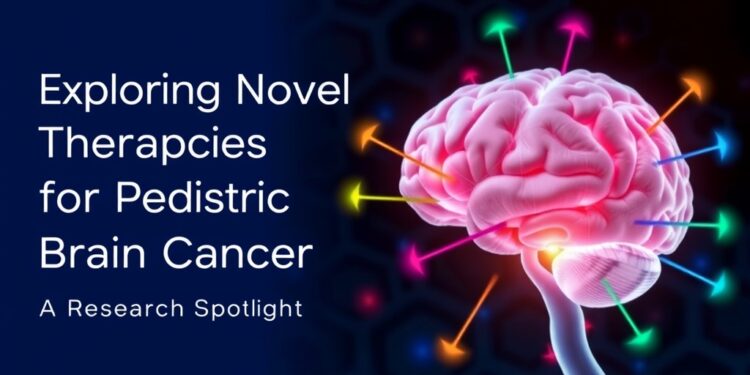
New Hope in Childhood Brain Cancer: A Breakthrough Drug Combats Ependymoma
In a significant advancement in the fight against pediatric brain cancer, researchers have identified a promising new treatment for a common form of brain tumor known as ependymoma (EPN). Ependymoma predominantly affects children and has long posed challenges for clinicians, as existing therapies are limited and often ineffective. Despite the complexities of this disease, which arise from various molecular subgroups, this study brings forth a glimmer of hope, specifically for those diagnosed with a particular subtype of EPN.
Traditionally, the management of ependymoma has been dominated by surgical resection and radiation therapy. However, these approaches can be hindered by the tumor’s location within the brain and the harmful long-term effects associated with radiation treatment. These constraints have created an urgent need for alternative therapies that can provide better outcomes for patients while minimizing side effects. The research team behind this study hopes to address this critical gap in treatment options by leveraging existing drugs in innovative ways.
In an innovative approach, the research team utilized a mouse model that mimics the human condition of ependymoma. Specifically, they focused on subtypes that express the EPHB2 gene and fusion proteins such as ZFTA–RELA, which are known to drive tumor growth. By observing how these tumors behave in an immunocompetent setting, the researchers could investigate the potential of various FDA-approved drugs to inhibit their growth. The strategy of repurposing existing medications for new applications represents a forward-thinking approach in cancer research, paving the way for quicker implementation in clinical settings.
The crux of the research demonstrated that dasatinib, a drug initially developed for leukemia treatment, exhibited potent anti-tumoral effects on the EPHB2 and ZFTA–RELA fusion-driven ependymoma models. By blocking relevant molecular pathways like EPHB2 and ABL1, dasatinib impeded tumor growth, offering encouraging results. However, the effectiveness of this treatment did not solely stem from direct anti-tumor activity; it was also evident that dasatinib played a pivotal role in reprogramming the immune landscape surrounding the tumor.
One of the notable discoveries in the research was the presence of immune cells known as M2-like tumor-associated macrophages (TAMs), which typically promote tumor growth. As the tumors expanded, the frequency of these pro-tumoral immune cells increased. Interestingly, treatment with dasatinib altered this trajectory. It shifted the macrophages’ behavior towards an anti-tumor response, enhancing the body’s immune mechanisms against the cancer. This reprogramming was vital in enabling the immune system to recognize and attack tumor cells more effectively.
In a striking outcome, the study revealed that dasatinib led to complete tumor regression in 78% of the treated mice. This remarkable response underscores not only the drug’s potential efficacy but also highlights how modifying immune responses can serve as a strategic avenue for boosting cancer therapy. The treatment’s ability to induce such profound effects demonstrates promise for clinical application, particularly for patients with the EPHB2-driven molecular subgroup of ependymoma.
However, the researchers also found that the effectiveness of dasatinib relied heavily on the presence of CD8 T cells – the soldiers of the immune system that target and destroy cancer cells. When these critical immune cells were depleted, the benefits of dasatinib diminished significantly, and overall survival rates dropped. This finding draws attention to the importance of an intact immune system in optimizing therapeutic responses, suggesting a synergistic relationship between the drug’s action and the immune activity within the body.
The findings from this comprehensive study have crucial implications for future clinical trials. The research team’s work articulates a pathway for dasatinib’s application in treating children with ependymoma, advocating for its evaluation in clinical settings focused on pediatric patients. By establishing the drug’s efficacy in a preclinical model, the research ignites hope for a more effective treatment paradigm that not only targets the tumors but also harnesses the body’s immune defenses.
At its core, this study serves as a reminder of the ingenuity embedded in the realm of medical research. Through the strategic repurposing of existing drugs and the exploration of immune-based therapies, researchers can unveil new possibilities for tackling complex diseases such as ependymoma. As this research matures and enters clinical phases, it has the potential to improve survival rates and the quality of life for children battling this challenging form of cancer.
Ultimately, advancing novel treatments such as dasatinib may lead to significant breakthroughs in pediatric oncology. It stands as a testament to the continual efforts of scientists and clinicians who are dedicated to improving outcomes for affected patients. The journey towards effective cancer therapy is often long and arduous, yet studies like this kindle a flame of optimism, illuminating pathways toward innovative solutions that could redefine how we approach cancer treatment.
The need for further investigations and clinical trials remains paramount, but the initial findings are a step in the right direction. As more resources are devoted to understanding and combating ependymoma, there is hope that brighter futures await children diagnosed with this devastating disease.
This groundbreaking research not only underscores the importance of collaborative, interdisciplinary efforts in scientific inquiry but also highlights the critical role of the immune system in cancer response strategies. As developments unfold in the field of oncology, the narrative surrounding ependymoma is poised to transform, fostering hope where there was once despair.
Subject of Research: Ependymoma Treatment
Article Title: Targeting EPHB2/ABL1 restores antitumor immunity in preclinical models of ependymoma
News Publication Date: 22-Jan-2025
Web References: N/A
References: N/A
Image Credits: N/A
Keywords: Ependymoma, Childhood Cancer, Dasatinib, Immunotherapy, Pediatric Oncology, Tumor Microenvironment, Immune Response, Cancer Treatment, Molecular Subgroup, Clinical Trial.
Tags: addressing gaps in brain cancer therapiesalternative treatments for ependymomaependymoma breakthrough drugEPHB2 gene and brain tumorsimproving outcomes in pediatric oncologyinnovative therapies for childhood tumorslong-term effects of radiation therapymolecular subgroups of ependymomamouse model research in oncologypediatric brain cancer treatmentssurgical resection challenges in brain cancerZFTA–RELA fusion proteins in cancer





